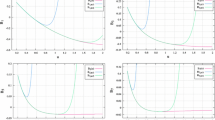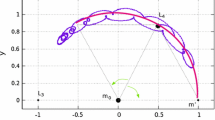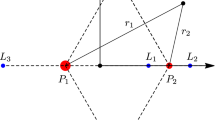Abstract
In previous publications the author has constructed a long-periodic solution of the problem of the motion of the Trojan asteroids, treated as the case of 1:1 resonance in the restricted problem of three bodies. The recent progress reported here is summarized under three headings:
-
(1)
The nature on the long-periodic family of orbits is re-examined in the light of the results of the numerical integrations carried out by Deprit and Henrard (1970). In the vicinity of the critical divisor
$$D_k \equiv \omega _1 - k\omega _2 ,$$not accessible to our solution, the family is interrupted by bifurcations and shortperiodic bridges. Parametrized by the normalized Jacobi constant α2, our family may, accordingly, be defined as the intersection of admissible intervals, in the form
$$L = \mathop \cap \limits_j \left\{ {\left| {\alpha - \alpha _j } \right| > \varepsilon _j } \right\};j = k,k + 1, \ldots \infty .$$Here, {αj(m)} is the sequence of the critical αj corresponding to the exactj: 1 commensurability between the characteristic frequencies ω1 and ω2 for a given value of the mass parameterm.
Inasmuch as the ‘critical’ intervals |α−αj|<εj can be shown to be disjoint, it follows that, despite the clustering of the sequence {αj} at α=1, asj→∞, the family extends into the vicinity of the separatrix α=1, which terminates the ‘tadpole’ branch of the family.
-
(2)
Our analysis of the epicyclic terms of the solution, carrying the critical divisorD k , supports the Deprit and Henrard refutation of the E. W. Brown conjecture (1911) regarding the termination of the tadpole branch at the Lagrangian pointL 3.
However, the conjecture may be revived in a refined form. “The separatrix α=1 of the tadpole branch spirals asymptotically toward a limit cycle centered onL 3.”
-
3.
The periodT(α,m) of the libration in the mean synodic longitude λ in the range
$$\lambda _1 \leqslant \lambda \leqslant \lambda _2$$is given by a hyperelliptic integral. This integral is formally expanded in a power series inm and α2 or\(\beta \equiv \sqrt {1 - \alpha ^2 }\).
The large amplitude of the libration, peculiar to our solution, is made possible by the mode of the expansion of the disturbing functionR. Rather than expanding about Lagrangian pointL 4, with the coordinatesr=1, θ=π/3, we have expandedR about the circler=1. This procedure is equivalent to analytic continuation, for it replaces the circle of convergence centered atL 4 by an annulus |r−1|<ε with 0≤θ<2π.
Similar content being viewed by others
References
Brown, E. W.: 1911,Monthly Notices Roy. Astron. Soc. 71, 438.
Deprit, A. and Henrard, J.: 1970 in G. E. O. Giacaglia (ed.),Periodic Orbits, Stability, and Resonances, D. Reidel Publ. Co., Dordrecht, Holland, p. 1.
Garfinkel, B.: 1977,Astron. J. 82, 368.
Garfinkel, B.: 1978,Celest. Mech. 18, 259.
Garfinkel, B.: 1980,Celest. Mech. 22, 267.
Author information
Authors and Affiliations
Rights and permissions
About this article
Cite this article
Garfinkel, B. Recent progress in the theory of Trojan asteroids. Celestial Mechanics 28, 153–154 (1982). https://doi.org/10.1007/BF01230667
Issue Date:
DOI: https://doi.org/10.1007/BF01230667




